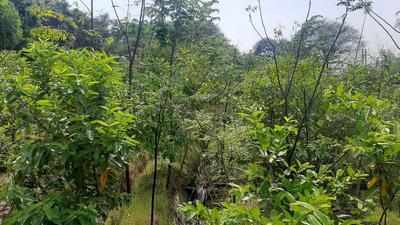- News
- City News
- hubballi News
- Urban forests spread their canopy in Davanagere
Trending
This story is from June 9, 2022
Urban forests spread their canopy in Davanagere

Scientists have successfully turned 15 guntas of wasteland into a verdant paradise in Dvanagere
Davanagere: Scientists of the local Taralabalu Krishi Vignana Kendra (TKVK) planted 5,000 saplings on 15 guntas of wasteland to counter the effects of rapid urbanisation and today it is an urban forest.
TKVK chief scientist Dr Devaraj said: “We have created trenches of 3 feet in depth and 2 feet in width and these were filled with all biodegradable waste before putting soil over it. Then the plants were placed keeping a gap of one foot between them.Water was fed through drip irrigation and the vegetation has flourished.”
Trees like honne, bamboo, pongamia, silver oak, teak, amla, sampige, neem, nerale, arali, Badami etc have been planted. They provide beauty and act as barriers to the dust and liberate more oxygen, Devaraj said.
“We planted over 2,000 saplings near Tolahunase, adjacent to Davanagere University, two years ago and they are now well grown too,” he said.
The Agriculture training school (ATS) at Kadajji village, near Davanagere, has also developed a small forest on a similar model on one-and-a-half acres of waste land. Two thousand saplings were planted on the ridges by digging trenches in the soil. They act as water conservation and soil conservation bunds now. This concept is also called 'Miyawaki forest' under Japanese style of cultivation, said Malathesh Puttannanavar, agriculture officer attached ATS.
Inspiring about the ‘Miyawaki forest’ concept adopted by TKVK and ATS, the Davanagere city municipal corporation (DCMC) has also launched a tree plantation programme in all its 45 wards in another two years, said corporator and former mayor S.T.Veeresh.
TKVK chief scientist Dr Devaraj said: “We have created trenches of 3 feet in depth and 2 feet in width and these were filled with all biodegradable waste before putting soil over it. Then the plants were placed keeping a gap of one foot between them.Water was fed through drip irrigation and the vegetation has flourished.”
Trees like honne, bamboo, pongamia, silver oak, teak, amla, sampige, neem, nerale, arali, Badami etc have been planted. They provide beauty and act as barriers to the dust and liberate more oxygen, Devaraj said.
“We planted over 2,000 saplings near Tolahunase, adjacent to Davanagere University, two years ago and they are now well grown too,” he said.
Clusters of mini forests could be developed preferably in waste lands which are unfit for agriculture or horticulture by anybody to develop greenery, Devaraj said.
The Agriculture training school (ATS) at Kadajji village, near Davanagere, has also developed a small forest on a similar model on one-and-a-half acres of waste land. Two thousand saplings were planted on the ridges by digging trenches in the soil. They act as water conservation and soil conservation bunds now. This concept is also called 'Miyawaki forest' under Japanese style of cultivation, said Malathesh Puttannanavar, agriculture officer attached ATS.
Inspiring about the ‘Miyawaki forest’ concept adopted by TKVK and ATS, the Davanagere city municipal corporation (DCMC) has also launched a tree plantation programme in all its 45 wards in another two years, said corporator and former mayor S.T.Veeresh.
End of Article
FOLLOW US ON SOCIAL MEDIA










